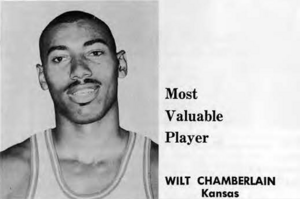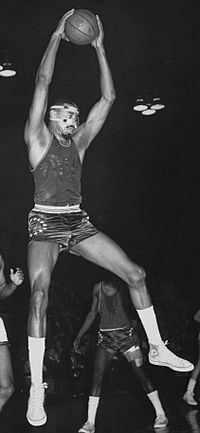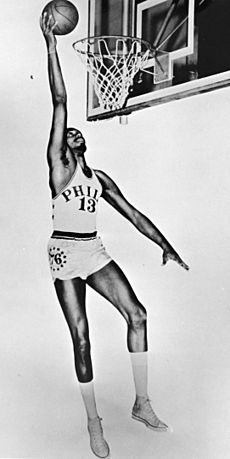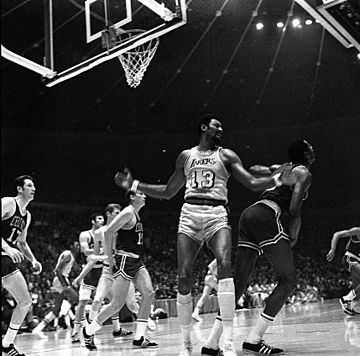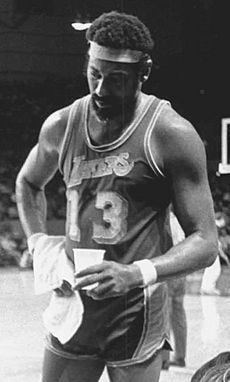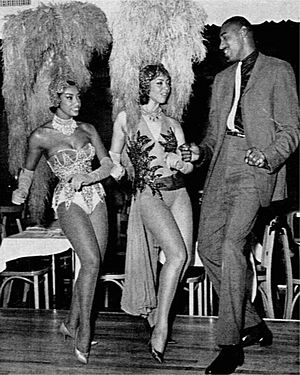Wilt Chamberlain facts for kids
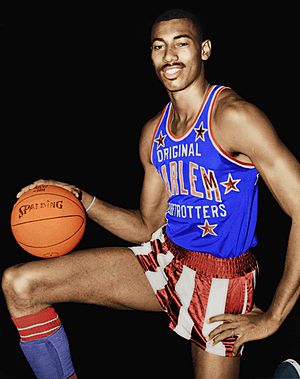
Chamberlain with the Harlem Globetrotters in 1959
|
|
| Personal information | |
|---|---|
| Born | August 21, 1936 Philadelphia, Pennsylvania, U.S. |
| Died | October 12, 1999 (aged 63) Los Angeles, California, U.S. |
| High school | Overbrook (Philadelphia, Pennsylvania) |
| Listed height | 7 ft 1 in (2.16 m) |
| Listed weight | 275 lb (125 kg) |
| Career information | |
| College | Kansas (1956–1958) |
| NBA Draft | 1959 / Pick: Territorial |
| Selected by the Philadelphia Warriors | |
| Pro career | 1958–1973 |
| Coaching career | 1973–1974 |
| Career history | |
| As player: | |
| 1958–1959 | Harlem Globetrotters |
| 1959–1965 | Philadelphia / San Francisco Warriors |
| 1965–1968 | Philadelphia 76ers |
| 1968–1973 | Los Angeles Lakers |
| As coach: | |
| 1973–1974 | San Diego Conquistadors |
| Career highlights and awards | |
|
|
| Career statistics | |
| Points | 31,419 (30.1 ppg) |
| Rebounds | 23,924 (22.9 rpg) |
| Assists | 4,643 (4.4 apg) |
Wilton Norman Chamberlain (August 21, 1936 – October 12, 1999) was an American professional basketball player. He played as a center and was 7 feet, 1 inch tall. He played in the National Basketball Association (NBA) for 14 years. Many people think he is one of the greatest players ever.
Chamberlain holds 72 NBA records. His former teammate, Billy Cunningham, once said, "The NBA Guide reads like Wilt's personal diary." He is famous for being the only player to score 100 points in a single NBA game. He is also the only player to average 50 points in a season. He never fouled out of a game in his career. He is the only player to average at least 30 points and 20 rebounds per game in a season, which he did seven times.
Wilt won two NBA championships. He also won four regular-season Most Valuable Player (MVP) awards. He was the Rookie of the Year and won one Finals MVP award. He also won one All-Star Game MVP award. He was chosen for thirteen All-Star Games. He was also named to ten All-NBA Teams.
Chamberlain played college basketball for the Kansas Jayhawks. He led Kansas to the national championship game in 1957. They lost to the North Carolina Tar Heels in three overtime periods. Before joining the NBA, he played for the Harlem Globetrotters. In the NBA, he played for the Philadelphia / San Francisco Warriors, the Philadelphia 76ers, and the Los Angeles Lakers.
Wilt had a big rivalry with Boston Celtics' center Bill Russell. He often lost to Russell's teams. Chamberlain was not good at free throws. He finally won his first NBA championship in 1967 with the 76ers. He won his second championship in 1972 with the Lakers. That Lakers team set a record with a 33-game winning streak.
Sportswriters gave Chamberlain several nicknames. These names often pointed out his great height. He did not like names like "Wilt the Stilt" or "Goliath". He preferred "The Big Dipper." This name came from his friends who saw him dip his head to walk through doorways. This name also inspired his "dipper dunk" move. He was one of the first players to use shots like the fade away jump shot and the finger roll. His success near the basket led to new rules. The lane was made wider. Offensive goaltending became illegal. It also became illegal to inbound the ball over the backboard.
Contents
- Early Life and Basketball Beginnings
- High School Career: Overbrook High School (1953–1955)
- College Career: University of Kansas (1956–1958)
- Professional Career: Harlem Globetrotters (1958–1959)
- NBA Career: Philadelphia/San Francisco Warriors (1959–1965)
- Philadelphia 76ers (1965–1968)
- Los Angeles Lakers (1968–1973)
- Coaching Career: San Diego Conquistadors (1973–1974)
- NBA Career Statistics
- Post-NBA Career and Other Interests
- Death
- Legacy and Impact
- Personal Life
- Images for kids
- See also
Early Life and Basketball Beginnings
Chamberlain was born on August 21, 1936, in Philadelphia, Pennsylvania. He was one of nine children. His mother, Olivia Ruth Johnson, was a homemaker. His father, William Chamberlain, was a welder and handyman. Wilt was a small child and almost died from pneumonia. He missed a whole year of school because of it.
Chamberlain was always very tall. He was already 6 feet tall at age 10. At first, he did not like basketball. He thought it was "a game for sissies." But basketball was very popular in Philadelphia. So, he started playing in 7th grade.
High School Career: Overbrook High School (1953–1955)
Chamberlain was 6 feet, 11 inches tall when he started at Overbrook High School. He was also a talented track and field athlete. He could high jump 6 feet, 6 inches. He ran the 440 yards in 49.0 seconds. He also put the shot 53 feet, 4 inches.
Wilt was the star player for the Overbrook Panthers basketball team. He wore jersey number 5. He was much taller and stronger than other players. He was known for his scoring, strength, and shot-blocking. ESPN journalist Hal Bock said Chamberlain was "scary, flat-out frightening." He changed the game with his athleticism. During this time, he got his nicknames: "Wilt the Stilt," "Goliath," and "The Big Dipper."
Chamberlain led his team to two city championships. Over three seasons, Overbrook had a great record of 56 wins and 3 losses. Wilt broke the Philadelphia high school scoring record. He finished with 2,252 points, averaging 37.4 points per game.
High School Championships
In 1953, Chamberlain averaged 31 points a game. His team won the Philadelphia Public League title. They played against West Catholic High School in the city championship. West Catholic used four players to guard Chamberlain. Even with his 29 points, the Panthers lost.
In 1954, Chamberlain scored a high-school record 71 points against Roxborough. The Panthers won the Public League title again. They also won the city title by beating South Catholic 74–50. He scored 32 points in that game. Overbrook finished the season with a perfect 19–0 record.
During summer, Chamberlain worked as a bellhop at Kutsher's Hotel. Red Auerbach, the coach of the Boston Celtics, saw him play there. Auerbach had Wilt play against college star B. H. Born. Chamberlain won 25–10. Born was so discouraged that he quit basketball.
In 1955, Chamberlain scored 74, 78, and 90 points in three games. Overbrook lost only one game that season. They won the Public League for the third time. They also won the city championship against West Catholic. Chamberlain scored 35 points in the final game. He was later named Mr. Basketball USA for 1955.
College Career: University of Kansas (1956–1958)
After high school, over 200 universities wanted Chamberlain to play for them. He chose the University of Kansas (KU). He liked the school's coach, Phog Allen.
Chamberlain was a member of the Kappa Alpha Psi fraternity. He was also a talented athlete at KU. He ran the 100-yard dash in 10.9 seconds. He also won the high jump in the Big Eight Conference championships three times.
Wilt's first game for the freshman team was exciting. They played against the varsity team, who were expected to win their conference. Chamberlain scored 42 points, grabbed 29 rebounds, and had 4 blocks.
Chamberlain's play led to new basketball rules in 1956. One rule said a free-throw shooter must stay behind the line. Wilt could reportedly jump 50 inches high. He could dunk free throws without a running start. Inbounding the ball over the backboard was also banned because of him. Offensive goaltending was also introduced.
Chamberlain's coach, Phog Allen, retired soon after Wilt joined KU. This disappointed Chamberlain. He had a difficult relationship with the new coach, Dick Harp.
Sophomore Season (1957): National Runner-up
On December 3, 1956, Chamberlain played his first varsity game for the Kansas Jayhawks. He scored 52 points and grabbed 31 rebounds. These were new Kansas records. The Jayhawks won 87–69.
Chamberlain was named first-team All-American. Teammate Monte Johnson said Wilt had "unbelievable endurance and speed." He was never tired. His moves like the finger roll and fadeaway jump shot were already very good.
Kansas played in the 1957 NCAA basketball tournament. The regional games were in Dallas, Texas, which was segregated then. The Jayhawks faced racial insults from the crowd. Police had to escort them out after games.
In the semi-finals, Kansas beat the defending champions, San Francisco Dons, 80–56. Chamberlain scored 32 points, grabbed 11 rebounds, and had at least seven blocked shots.
The NCAA finals were between Kansas and the undefeated North Carolina Tar Heels. North Carolina's coach, Frank McGuire, used special tactics to stop Chamberlain. They used three players to guard him. Kansas shot only 27% from the field. The game was tied at 46 at the end of regular time.
The game went into three overtimes. With 10 seconds left in the third overtime, North Carolina scored two free throws. Kansas lost 54–53. Despite the loss, Chamberlain was named the Most Outstanding Player of the Final Four. He scored 23 points and had 14 rebounds. Wilt later said this loss was the most painful of his life. It is still known as one of basketball's greatest games.
Junior Season (1958)
In Chamberlain's junior season (1957–58), opponents often used three or more players to guard him. This made games frustrating for him. He averaged 30.1 points. The Jayhawks finished with an 18–5 record. But they did not get invited to the NCAA tournament.
Chamberlain was again named an All-American. He decided to leave college to earn money. He sold his story, "Why I Am Leaving College," for $10,000. This was a lot of money then. In two seasons at KU, he averaged 29.9 points and 18.3 rebounds.
Professional Career: Harlem Globetrotters (1958–1959)
The NBA did not allow players to join until their college class had graduated. So, Chamberlain played for the Harlem Globetrotters in 1958. He earned $50,000. The team toured the Soviet Union in 1959. They met General Secretary Nikita Khrushchev.
Chamberlain often joined the Globetrotters in the off-season. He enjoyed his time there. He felt he was just one of many players who loved to entertain. On March 9, 2000, his No. 13 jersey was retired by the Globetrotters.
NBA Career: Philadelphia/San Francisco Warriors (1959–1965)
On October 24, 1959, Chamberlain made his NBA debut. He played for the Philadelphia Warriors. He was 7 feet, 1 inch tall and weighed 258 pounds. He became the NBA's highest-paid player. He signed for $30,000 in his first contract.
1959–60 NBA Season: MVP and Rookie of the Year
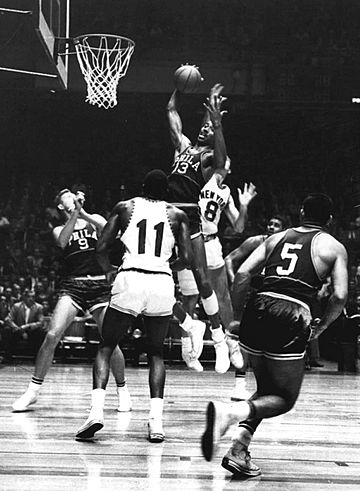
In his first NBA game, Chamberlain scored 43 points and grabbed 28 rebounds. In his third game, he had 41 points and 40 rebounds. On November 10, 1959, he recorded 39 points and 43 rebounds. On January 25, 1960, he scored 58 points and 42 rebounds against the Detroit Pistons.
In his first NBA season, Chamberlain averaged 37.6 points and 27 rebounds. He broke many records as a rookie. He scored 2,102 points in just 56 games. He was named both Rookie of the Year and MVP. He also won the All-Star Game MVP award.
The Warriors played the Boston Celtics in the playoffs. Celtics coach Auerbach told his players to foul Chamberlain hard. Wilt injured his hand in Game 3. The Warriors lost the series. Chamberlain thought about retiring because of the rough play. The Warriors' owner convinced him to return with a salary raise.
1960–61 NBA Season: Scoring and Rebounding Leader
Chamberlain continued to dominate in the 1960–61 NBA season. On November 24, 1960, he grabbed an NBA-record 55 rebounds. He averaged 38.4 points and 27.2 rebounds per game. He was the first player to score over 3,000 points in a season. He was also the first and only player to get over 2,000 rebounds in a season. He won his first field goal percentage title. The Warriors lost in the playoffs again.
1961–62 NBA Season: 100-Point Game
In the 1961–62 NBA season, Chamberlain set records that have never been broken. He averaged 50.4 points and 25.7 rebounds per game. He scored 4,029 points that season, the only player to break the 4,000-point mark. He also played an average of 48.53 minutes per game, almost every minute of every game.
On March 2, 1962, in Hershey, Pennsylvania, Chamberlain scored 100 points. He made 36 of 63 shots and 28 of 32 free throws. This was against the New York Knicks.
In the playoffs, the Warriors again met the Boston Celtics. The series went to Game 7. Chamberlain tied the game with 16 seconds left. But the Celtics won with a last-second shot. People criticized Chamberlain for not winning a title despite his high scoring. His coach said Wilt was "simply super-human."
1962–63 NBA Season: Move to San Francisco
In the 1962–63 NBA season, the Warriors team moved to San Francisco. They became the San Francisco Warriors. Many key players left the team. Chamberlain continued to put up amazing stats. He averaged 44.8 points and 24.3 rebounds. But the Warriors lost many games and missed the playoffs.
1963–64 NBA Season: First NBA Finals Loss
In the 1963–64 NBA season, Alex Hannum became the new coach. Rookie center Nate Thurmond joined the team. Hannum focused on defense and passing. Chamberlain averaged 36.9 points and 22.3 rebounds. The Warriors reached the NBA Finals. They lost to Russell's Boston Celtics 4–1.
Philadelphia 76ers (1965–1968)
1964–65 NBA Season: Trade to the 76ers
In the 1964–65 NBA season, the NBA widened the lane to 16 feet because of tall centers like Chamberlain. Wilt was traded to the Philadelphia 76ers. The Sixers had talented players like Hal Greer and Billy Cunningham.
Chamberlain averaged 34.7 points and 22.9 rebounds. He broke his nose in one game and had to wear a face mask. The Sixers met the Boston Celtics in the playoffs. The series went to Game 7. Chamberlain had 30 points and 32 rebounds. But the Celtics won by one point. This was the fifth time Russell's team beat Chamberlain's team in the playoffs. People started calling him a "loser."
1965–66 NBA Season: MVP Again
In the 1965–66 NBA season, Chamberlain won his second MVP award. He averaged 33.5 points and 24.6 rebounds. In one game, he blocked a dunk so hard that it dislocated the opponent's shoulder.
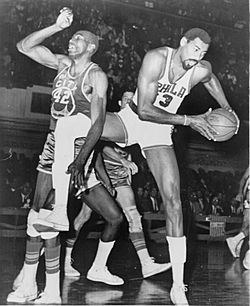
The Sixers again met the Boston Celtics in the playoffs. Boston won the series 4–1. Chamberlain was the only Sixers player who played well. But his teammates were upset because he sometimes skipped practice.
1966–67 NBA Season: First NBA Title
Before the 1966–67 NBA season, Alex Hannum became the Sixers' coach. Hannum was tough and earned Chamberlain's respect. He convinced Wilt to focus more on defense and passing.
Chamberlain averaged a career-low 24.1 points. But he was very efficient, shooting 68.3%. He led the league in rebounds (24.2). He was also third in assists (7.8). He played strong defense. For this, he won his third MVP award. The Sixers had a record-breaking season with 68 wins and 13 losses. Chamberlain also started praising his teammates. He invited them to dinner and paid the bill.
In the playoffs, the Sixers faced the Boston Celtics again. In Game 1, Chamberlain had an unofficial quadruple double with 24 points, 32 rebounds, 13 assists, and 12 blocks. The Sixers won the series 4–1. They ended Boston's eight-year championship streak.
In the 1967 NBA Finals, the Sixers played Chamberlain's old team, the San Francisco Warriors. The Sixers won the championship in Game 6. Chamberlain said, "It is wonderful to be a part of the greatest team in basketball." This team is considered one of the best in NBA history.
1967–68 NBA Season: Fourth MVP and Assist Leader
In the 1967–68 NBA season, Chamberlain continued to focus on team play. He averaged 24.3 points and 23.8 rebounds. On March 18, 1968, he reportedly had a quintuple-double with 53 points, 32 rebounds, 14 assists, 24 blocks, and 11 steals.
Chamberlain made history by leading the league in assists. He had 702 assists, more than any other center. He felt this showed he could pass the ball. He won his fourth and final MVP award. The 76ers had the best record in the league again.
In the playoffs, the Sixers met the Boston Celtics. The series was tied 3–1 in favor of the Sixers. But the Celtics came back and won the next two games. In Game 7, the Sixers lost 100–96. This was the first time a team lost a series after leading 3–1. Chamberlain had 14 points and 34 rebounds. He did not shoot much in the second half. After this season, Chamberlain asked for a trade.
Los Angeles Lakers (1968–1973)
1968–69 NBA Season: Second NBA Finals Loss
On July 9, 1968, Chamberlain was traded to the Los Angeles Lakers. He joined stars Elgin Baylor and Jerry West. Lakers owner Jack Kent Cooke gave Chamberlain a huge contract.
Chamberlain averaged 20.5 points and 21.1 rebounds. In the playoffs, the Lakers reached the NBA Finals against Russell's Boston Celtics. The Lakers were favored to win. They won the first two games but lost the next two. In Game 7, the Lakers lost by two points. Many wondered why Chamberlain sat out the final six minutes. He had an injured knee.
1969–70 NBA Season: First NBA Finals Loss to the Knicks
In the 1969–70 NBA season, Chamberlain started strong. But he had a serious knee injury in his ninth game. He missed several months. He returned for the last three games of the season. He still averaged 27.3 points, 18.4 rebounds, and 4.1 assists.
The Lakers reached the NBA Finals against the New York Knicks. The Knicks had star player Willis Reed. Reed was a tough matchup for Chamberlain. In Game 5, Reed injured his thigh. But the Knicks still won. In Game 6, Chamberlain scored 45 points and 27 rebounds. He helped the Lakers win. In Game 7, Reed famously played despite his injury. The Knicks won the game and the series.
1970–71 NBA Season: Conference Finals Loss
In the 1970–71 NBA season, the Lakers signed Gail Goodrich. Chamberlain averaged 20.7 points, 18.2 rebounds, and 4.3 assists. He led the NBA in rebounding again.
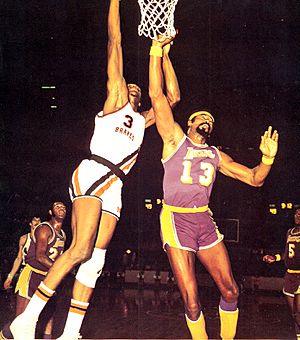
The Lakers lost key players to injuries. They were underdogs in the playoffs against the Milwaukee Bucks. The Bucks had young star Kareem Abdul-Jabbar. The Bucks won the series 4–1. Chamberlain played well against Abdul-Jabbar, who was 10 years younger.
After the playoffs, Chamberlain considered a boxing match against Muhammad Ali. He trained for it but later decided not to fight.
1971–72 NBA Season: Finals MVP and Second NBA Title
In the 1971–72 NBA season, Bill Sharman became the Lakers' coach. Sharman changed Chamberlain's role. He wanted Wilt to focus on defense and rebounding. Chamberlain became the new captain of the Lakers.
Chamberlain averaged a career-low 14.8 points. But he won the rebound crown with 19.2 rebounds per game. He also led the league with a 64.9% field goal percentage. The Lakers had an amazing 33-game winning streak. They finished the season with a record 69 wins.
In the playoffs, the Lakers swept the Chicago Bulls. Then they faced the Milwaukee Bucks and Abdul-Jabbar. Chamberlain helped the Lakers win in six games. He was praised for his play against the younger Abdul-Jabbar.
In the NBA Finals, the Lakers played the New York Knicks again. The Knicks were missing their injured star, Reed. In Game 5, Chamberlain played with a broken hand. He refused a painkilling shot. He had 24 points, 29 rebounds, 8 assists, and 8 blocked shots. The Lakers won their first championship in Los Angeles. Chamberlain was named the NBA Finals MVP.
1972–73 NBA Season: Last Season
The 1972–73 NBA season was Chamberlain's last. He averaged 13.2 points and 18.6 rebounds. He won the rebounding title for the 11th time. He also set an NBA record with a 72.7% field goal percentage. The Lakers won 60 games. They reached the NBA Finals against the New York Knicks. The Lakers had many injuries. The Knicks won the series 3–2. Chamberlain's last play in the NBA was a dunk.
Coaching Career: San Diego Conquistadors (1973–1974)
In 1973, the San Diego Conquistadors of the ABA league signed Chamberlain. He was a player-coach for $600,000. The Lakers sued him because he still had a contract with them. A judge ruled that Chamberlain could coach but not play for the Conquistadors.
Chamberlain mostly let his assistant coach handle the team. He was more interested in promoting his autobiography. He even skipped a game to sign books. In his only season as a coach, the Conquistadors had a 37–47 record. They lost in the playoffs. Chamberlain retired from basketball after this season.
NBA Career Statistics
| Legend | |||||
|---|---|---|---|---|---|
| GP | Games played | GS | Games started | MPG | Minutes per game |
| FG% | Field goal percentage | 3P% | 3-point field goal percentage | FT% | Free throw percentage |
| RPG | Rebounds per game | APG | Assists per game | SPG | Steals per game |
| BPG | Blocks per game | PPG | Points per game | Bold | Career high |
Regular season
| Year | Team(s) | GP | MPG | FG% | FT% | RPG | APG | PPG |
|---|---|---|---|---|---|---|---|---|
| 1959–60 | Philadelphia | 72 | 46.4* | .461 | .582 | 27.0* | 2.3 | 37.6* |
| 1960–61 | Philadelphia | 79* | 47.8* | .509* | .504 | 27.2 |
1.9 | 38.4* |
| 1961–62 | Philadelphia | 80* | 48.5 |
.506 | .613 | 25.7* | 2.4 | 50.4 |
| 1962–63 | San Francisco | 80* | 47.6* | .528* | .593 | 24.3* | 3.4 | 44.8* |
| 1963–64 | San Francisco | 80 | 46.1* | .524 | .531 | 22.3 | 5.0 | 36.9* |
| 1964–65 | San Francisco | 38 | 45.9 | .499* | .416 | 23.5 | 3.1 | 38.9* |
| 1964–65 | Philadelphia | 35 | 44.5 | .528* | .526 | 22.3 | 3.8 | 30.1* |
| 1965–66 | Philadelphia | 79 | 47.3* | .540* | .513 | 24.6* | 5.2 | 33.5* |
| 1966–67† | Philadelphia | 81* | 45.5* | .683* | .441 | 24.2* | 7.8 | 24.1 |
| 1967–68 | Philadelphia | 82 | 46.8* | .595* | .380 | 23.8* | 8.6* | 24.3 |
| 1968–69 | L.A. Lakers | 81 | 45.3* | .583* | .446 | 21.1* | 4.5 | 20.5 |
| 1969–70 | L.A. Lakers | 12 | 42.1 | .568 | .446 | 18.4 | 4.1 | 27.3 |
| 1970–71 | L.A. Lakers | 82 | 44.3 | .545 | .538 | 18.2* | 4.3 | 20.7 |
| 1971–72† | L.A. Lakers | 82 | 42.3 | .649* | .422 | 19.2* | 4.0 | 14.8 |
| 1972–73 | L.A. Lakers | 82* | 43.2 | .727* | .510 | 18.6* | 4.5 | 13.2 |
| Career | 1045 | 45.8 |
.540 | .511 | 22.9 |
4.4 | 30.1 | |
| All-Star | 13 | 29.8 | .590 | .500 | 15.1 | 2.7 | 14.6 | |
Playoffs
| Year | Team(s) | GP | MPG | FG% | FT% | RPG | APG | PPG |
|---|---|---|---|---|---|---|---|---|
| 1960 | Philadelphia | 9 | 46.1 | .496 | .445 | 25.8 | 2.1 | 33.2 |
| 1961 | Philadelphia | 3 | 48.0 | .489 | .553 | 23.0 | 2.0 | 37.0 |
| 1962 | Philadelphia | 12 | 48.0 | .467 | .636 | 26.6 | 3.1 | 35.0 |
| 1964 | San Francisco | 12 | 46.5 | .543 | .475 | 25.2 | 3.3 | 34.7 |
| 1965 | Philadelphia | 11 | 48.7 | .530 | .559 | 27.2 | 4.4 | 29.3 |
| 1966 | Philadelphia | 5 | 48.0 | .509 | .412 | 30.2 | 3.0 | 28.0 |
| 1967† | Philadelphia | 15 | 47.9 | .579 | .388 | 29.1 | 9.0 | 21.7 |
| 1968 | Philadelphia | 13 | 48.5 | .534 | .380 | 24.7 | 6.5 | 23.7 |
| 1969 | L.A. Lakers | 18 | 46.2 | .545 | .392 | 24.7 | 2.6 | 13.9 |
| 1970 | L.A. Lakers | 18 | 47.3 | .549 | .406 | 22.2 | 4.5 | 22.1 |
| 1971 | L.A. Lakers | 12 | 46.2 | .455 | .515 | 20.2 | 4.4 | 18.3 |
| 1972† | L.A. Lakers | 15 | 46.9 | .563 | .492 | 21.0 | 3.3 | 14.7 |
| 1973 | L.A. Lakers | 17 | 47.1 | .552 | .500 | 22.5 | 3.5 | 10.4 |
| Career | 160 | 47.2 |
.522 | .465 | 24.5 | 4.2 | 22.5 | |
Post-NBA Career and Other Interests
After coaching, Chamberlain became successful in business and entertainment. He invested in stocks and real estate. He also owned a popular nightclub in Harlem.
Athletics and Fitness
Chamberlain loved volleyball. He became a board member of the new International Volleyball Association (IVA) in 1974. He was even its president in 1975. He played in the IVA All-Star game and was named MVP. He was inducted into the IVA Hall of Fame. This made him one of the few athletes in different sports' Halls of Fame.
In the 1970s, he started Wilt's Athletic Club. It was a track and field club in California. Famous athletes like Florence Griffith Joyner trained there. Even in his mid-forties, he was very fit. He could still play well against young NBA players. He even thought about returning to the NBA in the 1980s.
Film Career
In 1976, Chamberlain started a film company. He made his first film, Go For It. He also played a villain in the 1984 movie Conan the Destroyer with Arnold Schwarzenegger. He was working on a movie about his own life when he died.
Death
Chamberlain passed away on October 12, 1999. He was 63 years old. He died at his home in Bel Air from congestive heart failure. His lawyer said Wilt was very curious and interested in many things.
Many NBA players and officials were sad. His rival and friend, Bill Russell, said their competition "bonded us together for eternity."
Legacy and Impact
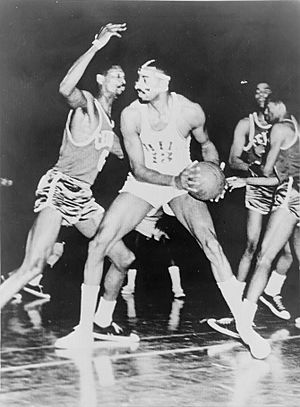
Chamberlain is seen as one of the most amazing basketball players ever. Some even say he was better than Michael Jordan. Other players were often scared to play against him.
Wilt holds many NBA records. He was a scoring champion seven times. He was the top rebounder eleven times. He also led the league in field goal percentage nine times. He led in minutes played eight times. He even led in assists once. His 100-point game is one of basketball's greatest records.
In high school and college, he was Mr. Basketball USA. He was also the NCAA Tournament Most Outstanding Player in 1957. His number 13 jersey was retired by many teams. These include the Kansas Jayhawks, Harlem Globetrotters, Golden State Warriors, Philadelphia 76ers, and Los Angeles Lakers.
Chamberlain won two NBA championships. He earned four MVP awards and Rookie of the Year. He also won a Finals MVP and an All-Star Game MVP. He was selected to 13 All-Star Games. He was named to 10 All-NBA Teams. He also made the All-Defensive First Team twice.
Wilt rarely fouled out of games. His career average was only two fouls per game. This is amazing because he played so many minutes. His game changed over the years. He started as a scorer. Then he became a rebounder and assist man. Later, he focused on defense.
Chamberlain was inducted into the Naismith Memorial Basketball Hall of Fame in 1978. He was named to the NBA 35th, 50th, and 75th Anniversary Teams. He is often ranked among the top basketball players of all time.
Rule Changes Because of Wilt
Chamberlain was so dominant that he caused several NBA rule changes.
- The lane was widened to keep big players farther from the basket.
- Offensive goaltending became illegal.
- Dunking to make free throws was banned.
- Rules for inbounding the ball were changed. For example, it became illegal to inbound the ball over the backboard.
Personal Life
Star Status
Chamberlain was the first basketball player to earn a lot of money. He was the highest-paid player when he joined the NBA. He was the first to earn at least $100,000 a year. He earned $1.5 million during his Lakers years. He could afford to live in New York City and travel to Philadelphia for games.
Jazz composer Thad Jones named a song "Big Dipper" after Chamberlain. When he was a Laker, Chamberlain built a huge mansion in Bel-Air. It was named after Ursa Major, like his nickname "The Big Dipper." He lived alone with his cats and dogs. He drove luxury cars like a Ferrari and a Bentley.
When he died in 1999, Chamberlain's estate was worth $25 million.
Politics
Chamberlain supported Republican Richard Nixon in the 1968 and 1972 presidential elections. He considered himself a Republican.
Images for kids
-
Chamberlain statue in South Philadelphia
- List of basketball players who have scored 100 points in a single game
- List of National Basketball Association annual field goal percentage leaders
- List of National Basketball Association annual minutes leaders
- List of National Basketball Association annual rebounding leaders
- List of National Basketball Association career free throw scoring leaders
- List of National Basketball Association career minutes played leaders
- List of National Basketball Association career playoff free throw scoring leaders
- List of National Basketball Association career playoff rebounding leaders
- List of National Basketball Association career playoff scoring leaders
- List of National Basketball Association career rebounding leaders
- List of National Basketball Association career scoring leaders
- List of National Basketball Association franchise career scoring leaders
- List of National Basketball Association longest winning streaks
- List of National Basketball Association rookie single-season rebounding leaders
- List of National Basketball Association rookie single-season scoring leaders
- List of National Basketball Association single-game assists leaders
- List of National Basketball Association single-game playoff scoring leaders
- List of National Basketball Association single-game rebounding leaders
- List of National Basketball Association single-game scoring leaders
- List of National Basketball Association single-season rebounding leaders
- List of National Basketball Association single-season scoring leaders
- List of NCAA Division I men's basketball players with 30 or more rebounds in a game
See also
 In Spanish: Wilt Chamberlain para niños
In Spanish: Wilt Chamberlain para niños



